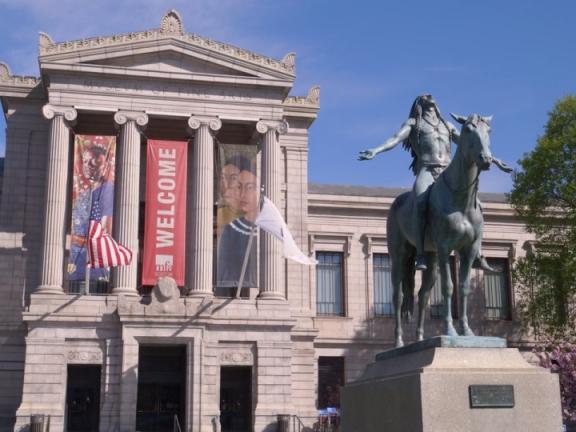A Complicated Past
In 1912, when the MFA installed Cyrus Dallin’s Appeal to the Great Spirit at its Huntington Avenue Entrance, the sculpture was a contemporary work of art. The Museum’s leaders at that time did not intend for it to remain in front of the building permanently but it has stood there ever since. Depicting a Native American man astride a horse with his arms outstretched, Appeal to the Great Spirit has become an icon of the MFA and one of the most reproduced objects in the collection. A part of the Museum’s history, it has entered today’s international debates about cultural appropriation, public monuments, and Indigenous erasure.
Critics in the early 20th century praised Dallin’s sculpture for its “fine dignity” while describing its figure as representative of a “dying race.” Dallin himself likely believed his works honored Indigenous peoples and even critiqued the social injustices that they faced. Years after completing Appeal to the Great Spirit and other major sculptures of Indigenous figures, like Massasoit (1920), which stands at the top of Cole’s Hill in Plymouth, Massachusetts, Dallin became a Native rights activist, telling the Boston Globe, “The attitude of white people toward Indians in general is one of supreme arrogance.” Like the art critics of his time, Dallin had a limited perspective on his work. He likely saw Appeal to the Great Spirit as different from negative images of Native people, even though it perpetuated the “vanishing race” stereotype with its anonymous, unarmed figure dressed in a mix of Lakota- and Diné-style regalia. But what about the responses to Appeal to the Great Spirit that went unrecorded? What did Massachusett, Wampanoag, and other local Indigenous people think about this sculpture in 1912?
Reckoning with History
We cannot recover unrecorded voices from the past, but we have sought to look beyond our walls, to the community members who live with this sculpture in public space today, to help us tell its many stories. Beginning in October 2019, as part of the MFA’s first Indigenous Peoples’ Day celebration, we invited people from all backgrounds, including Indigenous artists, Dallin scholars, and MFA visitors, to answer the question, “What do you see when you look at Cyrus Dallin’s Appeal to the Great Spirit?” The range of perspectives, represented below, continue to inform how we contextualize, interpret, and publicly present this sculpture.
Join the Conversation
Connect with our curatorial team at [email protected] or on Instagram @americasmfa, where Appeal to the Great Spirit is featured on our Story Highlights.





